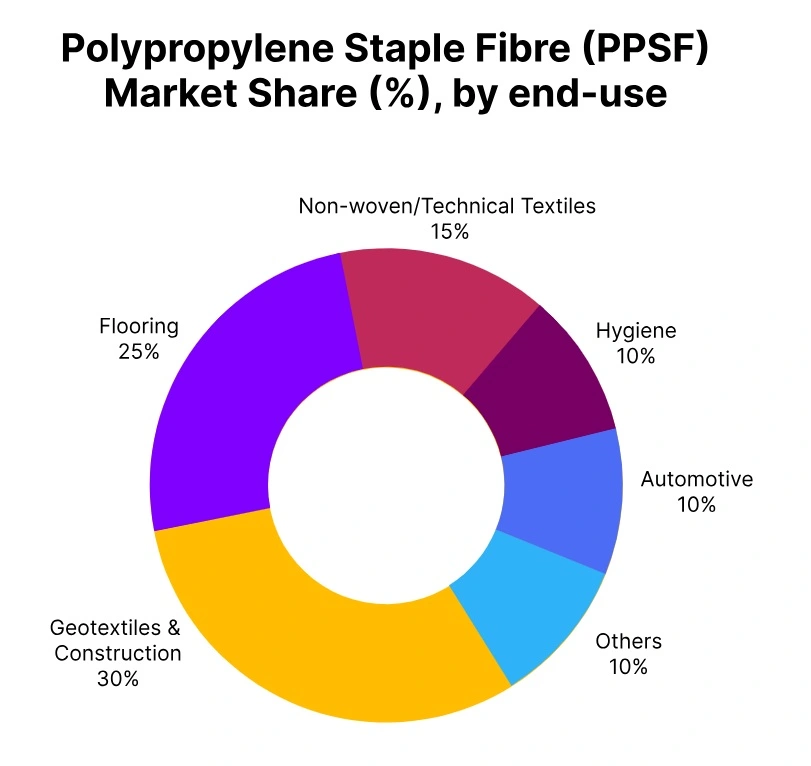Price-Watch’s most active coverage of Polypropylene Staple Fibre (PPSF) price assessment:
- 6D/ 90mm FOB Shanghai, China
- 3.0D/ 51 mm Ex-Ahmedabad, India
- 6D/ 90mm CIF Chittagong (China), Bangladesh
- 6D/ 90mm CIF Melbourne (China), Australia
- 6D/ 90mm CIF Bangkok (China), Thailand
- 6D/ 90mm CIF Port Kelang (China), Malaysia
- 6D/ 90mm CIF Haiphong (China), Vietnam
Polypropylene Staple Fibre (PPSF) Price Trend Q3 2025
In Q3 2025, the global Polypropylene Staple Fibre prices showed a marginally declining trend, with reductions of 2–3% recorded in several regions due to soft feedstock propylene costs and subdued demand from nonwoven, automotive, and apparel segments.
Polypropylene Staple Fibre (PPSF) price trend in September 2025 reflected cautious procurement, competitive offers from regional suppliers, and the impact of variable freight rates, which occasionally tempered sharper downward movements.
China
Polypropylene Staple Fibre (PPSF) Export prices FOB Shanghai, China, Grade- 6D/90mm.
Polypropylene Staple Fibre price in China recorded a dipping price trend in Q3 2025, declining by 2–3% from the previous quarter. The Polypropylene Staple Fibre (PPSF) price trend in China reflected softer demand from nonwoven manufacturers and a slowdown in downstream orders, especially from hygiene and geotextile segments, prompting competitive export activity and steady operating rates.
Sellers encouraged restocking through transparent discounting, but global supply/demand imbalance and stable freight conditions left minimal room for recovery. In September 2025, Polypropylene Staple Fibre prices in China settled between USD 1080 and 1180 per metric ton, as muted consumption prevailed and buyers kept short-term focus.
India
Polypropylene Staple Fibre (PPSF) Domestic prices Ex Ahmedabad, India, Grade- 3D/51 mm.
Polypropylene Staple Fibre price in India remained stable to weak in Q3 2025, as a result a flat or gently decreasing price trend compared to Q2. The Polypropylene Staple Fibre (PPSF) price trend in India responded to balanced local supply and demand, where ongoing production provided adequate coverage for textile and nonwoven converters.
Seasonal ordering and cautious purchasing shaped slight spot adjustments, while local freight and input costs provided moderate support. In September 2025, Polypropylene Staple Fibre prices in India closed between USD 1350 and 1430 per metric ton, reflecting cautious inventory approaches and selective restocking by key buyers.
Bangladesh
Polypropylene Staple Fibre (PPSF) Import prices CIF Chittagong, Bangladesh, Grade- 6D/90mm.
Polypropylene Staple Fibre price in Bangladesh sustained a steady to slightly lower trend in Q3 2025, showing minor reductions counterbalanced by an uptick in import freight costs. The Polypropylene Staple Fibre (PPSF) price trend in Bangladesh resulted from stable demand across home textile, carpet, and geotextile sectors, with higher landed costs pushing buyers towards strategic procurement and flexible volume management. September 2025 highlighted cautious restocking strategies and ongoing cost vigilance among importers.
Australia
Polypropylene Staple Fibre (PPSF) Import prices CIF Melbourne, Australia, Grade- 6D/90mm.
According to Price-Watch, Polypropylene Staple Fibre price in Australia showed a stable to gently easing trend in Q3 2025, as modest freight hikes kept steeper declines in check. The Polypropylene Staple Fibre (PPSF) price trend in Australia was shaped by constant demand from hygiene and textile users, coupled with defensive purchasing in view of a globally oversupplied market. September 2025 saw improved landed costs driving moderate restocking and maintaining overall price steadiness.
Thailand
Polypropylene Staple Fibre (PPSF) Import prices CIF Bangkok, Thailand, Grade- 6D/90mm.
Polypropylene Staple Fibre price in Thailand followed a downward price trend in Q3 2025, dropping 2% from the last quarter. The Polypropylene Staple Fibre price trend in Thailand reflected an environment favorable to buyers, as stable freight and surplus supply empowered converters and nonwoven manufacturers to negotiate discounts and optimize inventory levels. In September 2025, flexible restocking and competitive contract offers continued to define the market.
Malaysia
Polypropylene Staple Fibre (PPSF) Import prices CIF Port Kelang, Malaysia, Grade- 6D/90mm.
Polypropylene Staple Fibre price in Malaysia slipped close to 2% in Q3 2025, maintaining a soft price trend as surplus persisted. The Polypropylene Staple Fibre (PPSF) price trend in Malaysia was defined by textile, nonwoven, and industrial users securing lower-cost imports, while spot negotiations and careful restocking dominated market behaviour. September 2025 showed sustained buyer vigilance and gradual, demand-driven market improvement.
Vietnam
Polypropylene Staple Fibre (PPSF) Import prices CIF Haiphong, Vietnam, Grade- 6D/90mm.
Polypropylene Staple Fibre price in Vietnam decreased by around2% in Q3 2025, underlining a gentle downward price trend. The Polypropylene Staple Fibre price trend in Vietnam showed global price patterns, as supply-side discounts and stable freight fostered softer costs. September 2025 emphasized careful import planning and flexible contracts, leaving the market poised for further adjustment should end-use demand strengthen during subsequent quarters.




